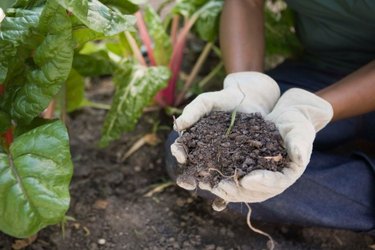Things You'll Need
Flashlight
Bacillus thuringiensis or spinosad
Carrots
Beneficial nematodes
Boiling water

The garden soil is home to many harmful insects that do damage to both your younger and older plants. Bugs, such as grubs, spend their time in the ground damaging plant roots, cutting stems below the soil level and feeding on underground plant parts. It is difficult to treat these pests because you do not see the damage happening until it is too late, but you do have the option to use organic or chemical treatments that successfully kill the bugs in your garden soil.
Step 1
Wait until night and then bring a flashlight to spot the cutworms, which are brown caterpillars that chew seedling stems at the soil level. Handpick the cutworms that you find and dispose of them. If you prefer an insecticide, spray bacillus thuringiensis or spinosad by following the instructions on the container. Generally, these sprays are applied to areas where cutworms feed so they ingest the solution and die.
Video of the Day
Step 2
Catch the yellow, cylindrical wireworm larvae that feed on the roots of sprouting seeds and emerging seedlings. Bury a large carrot every 2 1/2 feet to 3 feet in your garden soil to entice these larvae and then pull up the carrot in two to three days to remove and dispose of the wireworms. Replace the carrots and repeat this process to continue to catch and kill wireworms.
Step 3
Insect the roots of your stunted plants that tend to wilt in the day's heat to locate the tiny white worms known as root maggots. Apply beneficial nematodes, which are small microscopic worms that naturally eliminate these pests. Nematodes are typically mixed with water and sprayed on garden soil, but follow the instructions that come with your nematodes. If you discover that the plant roots are infested with maggots, immediately pull up the plant and dispose of it. Root maggots not only disfigure crops, but they also provide an ideal environment for rot diseases to occur.
Step 4
Check for mounds in your garden soil where fire ants emerge to feed on germinating seeds and young shoots. Boil water and then pour the water while it is still boiling on the mounds to kill the fire ants.
Tip
If you use insecticides, wear protective clothing, such as long pants and a long-sleeved shirt, to keep your exposure to a minimum.
Warning
Always read the label on your insecticide to ensure that the product is appropriate for the type of insect and plant that you want to apply it to.
Video of the Day
- Texas A&M University: Soil Insects
- University of California: Cutworms
- University of California: Wireworms
- National Gardening Association: Root Maggot
- National Gardening Association: Fire Ants
- Alabama Cooperative Extension System: Garden Bugs
- Colorado State University: Insects and Pests
- National Gardening Association: Pest Control Library